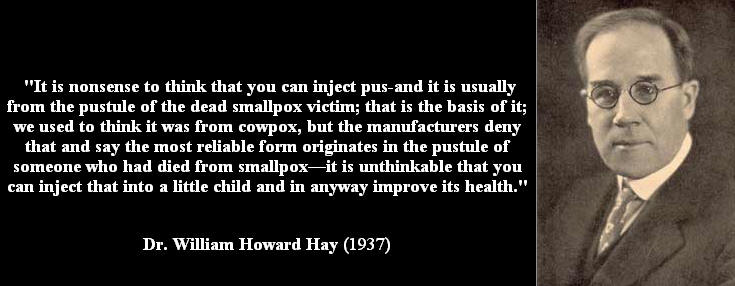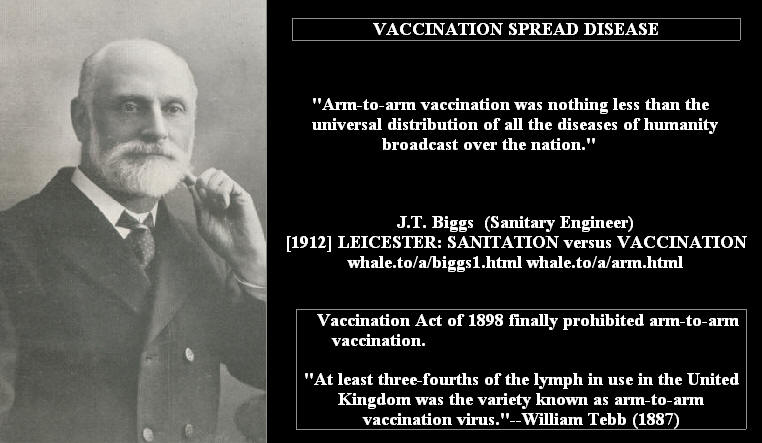
Hay, 1937, Dr. William Howard
Arm to arm vaccination
quotes
Smallpox
quotes
[This was the method used in 3/4's of vaccinations in 1893, banned in 1898. How to spread human diseases the easy way: Erysipelas Leprosy Lockjaw (tetanus) Spread of Smallpox Syphilis TB/consumption. Not that animal diseases are bet
ter: SV40 (polio vaccines), Bovine TB, Brucellosis.]"It is nonsense to think you can inject pus-and it is usually from the pustule of the dead smallpox victim; that is the basis of it; we used to think it was from cowpox, but the manufacturers deny that and say the most reliable form originates in the pustule of someone who had died from smallpox-it is unthinkable that you can inject that into a little child and in any way improve its health." Hay, 1937, Dr. William Howard

J.T. Biggs Smallpox spread by
vaccine quotes (vaccine damage)
Vaccine "lymph" and disease
spread
"The largest number of lepers segregated in any one year was in 1873, when the numbers received at the leper settlement, Molokai, according to the official reports, was 487, for several years previous to which arm-to-arm vaccination has been prosecuted with great and unparalleled energy. "--Tebb
The so-called " humanized lymph," which was obligatory for nearly eighty years, had finally to be condemned, and, since 1898, " calf lymph which no Public Vaccinator had previously been allowed to use, has replaced arm-to-arm vaccination." [1933] The Golden Calf by Charles W. Forward
"The chief of the Public Health Department was clearly not aware that until a comparatively recent period arm-to-arm vaccination was practically the only method in vogue; and at the time Mr. Ritchie’s declaration was made, to the effect that none of the lymph in use had passed through the human body, at least three-fourths of the lymph in use in the United Kingdom was the variety known as arm-to-arm vaccination virus."--William Tebb 1893
"Vaccination," by which term is meant the inoculation of cowpox from cow to man and thence from arm to arm, in distinction from the old direct smallpox inoculation from human to human. Higgins, Chas
Vaccination Act of 1898 finally prohibited arm-to-arm vaccination
A WHO year 2000 document. You can
imagine the organisms growing in vaccine lymph:
Incorrect handling of an opened vaccine vial can result in contamination of
the reconstituted liquid with staphylococcal or other organisms. The organisms
are able to grow in the liquid, all the more so if kept in a warm environment.
Left for more than a few hours, the staphylococcus organism produces large
quantities of toxin. If the vaccine contaminated with toxin is then used, the
recipient can die within hours or become desperately ill. If recognized soon
enough, the condition is possible to treat, but often the diagnosis is made too
late and the child dies. Tragically, several children are usually affected
simultaneously through use of the same contaminated vial.
Supplementary information on vaccine safety WHO/V&B/00
Yet arm-to-arm vaccination was practised by medical men for about a century ; for nearly half a century it has been enforced upon the whole population by law, involving fine, distraint, or imprisonment. The medical profession and the Government rigidly upheld the practice, but they are now compelled by force of circumstances to admit—what anti-vaccinators have affirmed all along—that arm-to-arm vaccination was dangerous, causing widespread disease, and often resulting in death. Now that they have condemned the practice, they recommend calf lymph, apparently forgetting or overlooking the fact that vaccination from the cow was tried, and rejected, by medical practitioners more than a century ago.LEICESTER: SANITATION versus VACCINATION BY J.T. BIGGS J.P.
"First came what was called "arm-to-arm vaccination." This consisted of inoculation with pus from the sore of a vaccinated person. Then it was arm-to-arm vaccination that became "one of the best established of medical facts" and "highly salutary to the human race." But, alas, for this improvement! Its continued practice brought the discovery that scrofula, tuberculosis, and even worse diseases latent in the constitution of the subject from whom the vaccine virus was taken, were being sown among the people.22 The growing doubt and agitation in the public mind finally led in England to the appointment of a Royal Commission -- to investigate the subject. This Commission, of which Lord Herschell was chairman, was in session for seven years -- from 1889 to 1896 -- and received the testimony of experts from all parts of the civilized world. Its report is comprised in fourteen folio volumes and constitutes the most exhaustive collection of medical evidence ever taken.23 Though out of the sixteen members of the Commission only three were anti-vaccinists yet the result of its investigation was the passage by Parliament of the "Conscience Clause" of the Vaccination Acts. This clause, passed in 1898, exempted from vaccination the children of parents who declared a conscientious objection to the practice. England, the birthplace of vaccination, after a century of experience of its disastrous effects, thus freed her people from its enforcement.24 The testimony taken before the Commission not only caused the enactment of the Conscience Clause, it proved also the death blow of arm-to-arm vaccination."---- John Pitcairn
"The use of clean lancets and healthy vaccinifers without hereditary taint, however much insisted upon, cannot be made compulsory; and the people are obliged under severe penalties to submit to whatever vaccination is offered, which is chiefly of the leprous and syphilitic variety, collected from miscellaneous native vaccinifers by perfunctory public vaccinators. Indeed, as I have found by personal inquiries in the West Indies, South Africa, and Hawaii, all the precautions admitted to be indispensable for the safe performance of the official rite are habitually disregarded."--William Tebb http://www.whale.to/v/tebb/9.html
In the
"Times," of 16th March, 1898, Mr. Chaplin, on introducing the Vaccination Bill,
and referring to the Final Report of the Royal Commission, is thus reported......"I may remind the House that there have been some remarkable
discoveries in recent years, and if we take
advantage of them, as I hope and believe we shall,
they will go far to revolutionise the whole of the
previous system of public vaccination. I am
referring to the results which it is proved are
obtained from the preservation of lymph taken from the calf in glycerine. .
........it appears that calf lymph preserved in this
way possesses remarkable properties and advantages. In the first place, all
extra organisms when the lymph is mixed with glycerine are destroyed. For
instance, it is found that such organisms as the microbes of tubercle,
erysipelas, and diphtheria, and other diseases (even when they have been added
for the purpose of experiment) very shortly disappear, although it retains
its full activity for vaccination purposes.
"Secondly,
it can be kept for long periods, and upon an emergency large quantities can
with facility be supplied; and, thirdly, which is a matter of the first
importance, the necessity for arm-to-arm vaccination, and consequently all
risk and possibility of inoculation with syphilis, whatever it may have been
heretofore, wholly disappears. On this point the Commission makes two
suggestions—that lymph shall be placed within the reach of all, and that no
parents shall be required to submit their children for vaccination by means of
anything but calf lymph." CH 61
LEICESTER: SANITATION versus VACCINATION
BY J.T. BIGGS J.P. 1898
Scientific American, Inc. JANUARY 1901: SMALLPOX VACCINE PRODUCTION--"Until 1876 arm-to-arm vaccination was usually practiced in New York, the lymph being taken only from a vesicle of a previously vaccinated child a few months old. But human lymph has always been objectionable, in that it is a possible source of infection of a most serious blood disease. In 1876 the city Health Department laid the groundwork for the present vaccine laboratory. A calf has vaccine (cowpox) virus smeared into superficial linear incisions made on the skin. In a few days, vesicles appear, and it is from these that the virus is obtained. Virus that has been emulsified in glycerine is drawn up into small capillary glass tubes, each tube containing enough virus for one vaccination." JANUARY 1951 http://www.sciam.com/article.cfm?articleID=0007F27B-3E6F-1CDF-B4A8809EC588EEDF
"Before the advent of refrigeration, this public health boon was disseminated by passing the pustular material from a vaccination site (which ripens in about 10 days) to the arm of an unvaccinated person. The Spanish Empire brought smallpox vaccination to the New World on the arms of 22 orphans, two vaccinated every 10 days on the transatlantic voyage. An orphanage in St. Petersburg kept a chain of "arm-to-arm" vaccination going from 1801 to 1893." http://www.miis.edu/offsite_press/Washington%20Post%20Oct%2021,%202001b.htm
"The María Pita left the Spanish
harbor of La Coruña on November 30, 1803, with the smallpox vaccination
expedition team consisting of a director, Dr. Francisco Xavier Balmis; an
assistant director, Dr. Jóse Salvany Lleopart; and several assistants and
paramedics. The ship reached Puerto Rico in February 1804 with its cargo of
vaccine serum preserved between sealed glass plates; also onboard were 21
children from the orphanage at La Coruña who carried the vaccine through
arm-to-arm vaccinations performed sequentially during the ship’s journey, and
thousands of copies of a treatise describing how to vaccinate and preserve the
serum, recounts José Rigau-Pérez in an article on the smallpox vaccine in Puerto
Rico.
From Cartagena, Dr. Salvany sent
the vaccine to Portobelo and Panama, where thousands were vaccinated, and he
made arrangements to take 10 children from the city orphanage to carry the
vaccine through arm-to-arm vaccination to Santafé de Bogotá. During the
rigorous, rain-soaked journey in a riverboat up the Magdalena River from the
Caribbean coast to Santafé, in the highlands, Dr. Salvany developed an illness
that resulted in the loss of one eye. Nevertheless, in every river port where
the boat stopped, the expedition team landed to vaccinate people–more than
56,000 altogether."
http://www.paho.org/English/DPI/Number11_article6.htm
At Oxford House on Apr. 15, 1838, John Todd described explicitly how arm-to-arm vaccination was performed: "The subjects were vaccinated with fresh serum taken from the previously vaccinated eight days before."Hudson's Bay Company, Provincial Archives of Manitoba, B.156/a/17, Oxford House, 18371838, fo 3d.Meanwhile, arm-to-arm vaccination remained the common practice in France until 1864 and was popular in Britain until 1881; calf lymph suspended in glycerol then came into use. In Britain the Vaccination Act of 1898 finally prohibited arm-to-arm vaccination http://collection.nlc-bnc.ca/100/201/300/cdn_medical_association/cmaj/vol-161/issue-12/1543.htm#vari